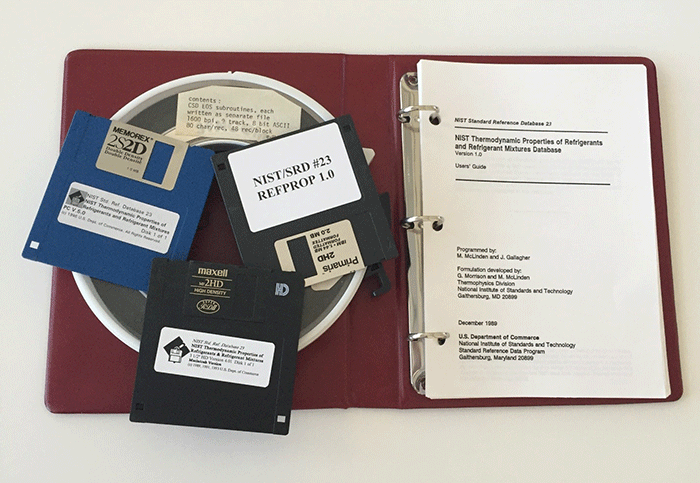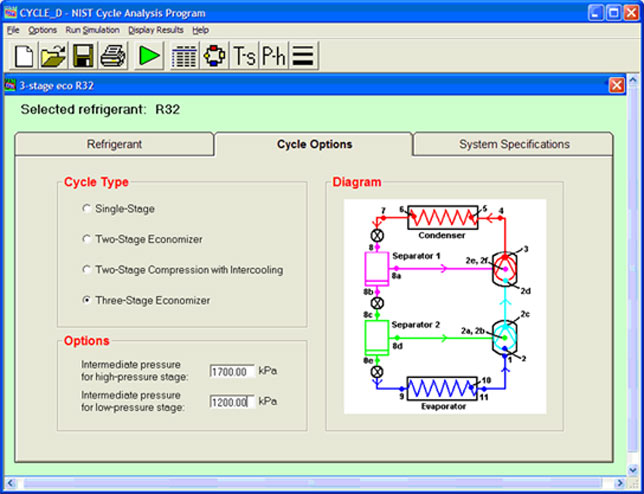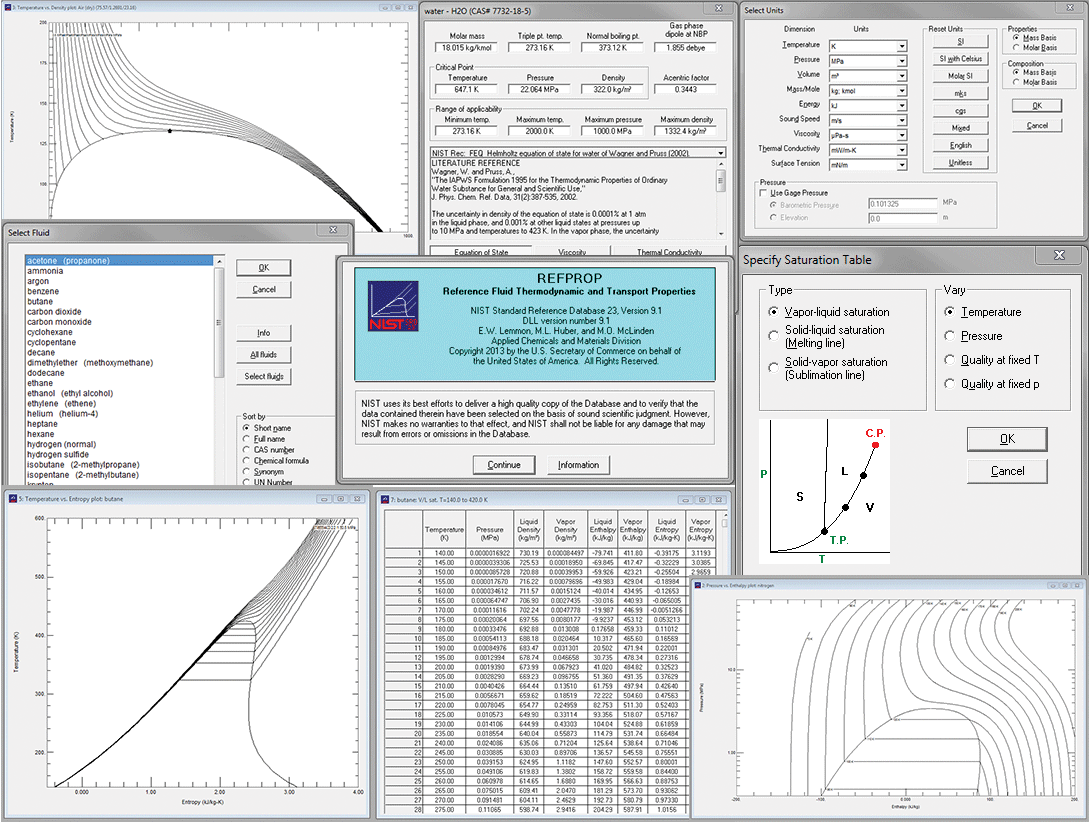NIST computer program REFPROP. The model is a modification of a one-fluid, extended corresponding states (ECS) model for thermal conductivity and viscosity originally developed by Ely and Hanley (Ind. Fundam., 1981, 20:323-332). We apply the model to. Background Our company had an internal need to develop a RefProp C# interface that would enable calling the RefProp native FORTRAN methods from a Windows C# program. Discussions with the RefProp development team at NIST met with great enthusiasm and they helped guide us in the development of an open source project named IRefProp64, programs to quickly and easily call RefProp. Enhancements have been made to most areas of the NIST REFPROP program, including the equations of state for many of the pure fluids and mixtures, the transport equations, the graphical interface, the Excel spreadsheet, the Fortran files (i.e., core property routines), the sample programs in Python, C, MATLAB, VB, etc. Single-compound fluids can be combined to form blends of up to ten components. Computationally, the program is fully compatible with the NIST Reference Fluid Thermodynamic and Transport Properties - REFPROP, Version 10.0. The NIST REFPROP program is designed to provide the most accurate thermophysical properties currently available for pure fluids and their mixtures. The present version is limited to vapor-liquid equilibrium (VLE) only and does not address liquid-liquid equilibrium (LLE), vapor-liquid-liquid equilibrium (VLLE) or other complex forms of phase.
Effective immediately, there will be a minimum $30.00 shipping charge for all international shipments of databases via UPS International. Customer will be responsible for their own duties, tax, and VAT. Contact (844) 374-0183 (Toll Free), ordata@nist.govif you have questions. Payment Instructions
Please be advised that we no longer accept purchase orders under $2500.00.
The database numbers are an indication only of the order in which these products were developed.

Number | Title | Price |
|---|---|---|
| SRD 1A | NIST/EPA/NIH Mass Spectral Library with Search Program (Data Version: NIST 20, Software Version 2.4) This database is the product of an ongoing comprehensive evaluation and expansion of the world's most widely used mass spectral reference library.Read More | distributor only |
NIST Thermophysical Properties of Hydrocarbon Mixtures, Version 3.2 SUPERTRAPP is an interactive computer program for predicting thermodynamic and transport properties of pure fluids and fluid mixtures containing up to 20 components. Read More | $200 | |
NIST/ASME Steam Properties Database: Version 3.0 Based upon the International Association for the Properties of Water and Steam (IAPWS) 1995 formulation for general and scientific use for the thermodynamic properties of water, this updated version provides water properties from the international standards over a wide range of conditions.Read More | $100 | |
NIST Reference Fluid Thermodynamic and Transport Properties Database: Version 10 REFPROP is an acronym for REFerence fluid PROPerties. This program calculates the thermodynamic and transport properties of industrially important fluids and their mixtures. These properties can be displayed in tables and plots through the graphical user interface; they are also accessible through spreadsheets or user-written applications accessing the REFPROP DLL or the FORTRAN property subroutines . REFPROP is based on the most accurate pure fluid and mixture models currently available. Read More | $325.00 | |
NIST-ACerS Phase Equilibria Diagrams Database Phase Equilibria Diagrams, (Standard Reference Database SRD 31), published from 1964 to 1992 as the well-known Phase Diagrams for Ceramists 'blue books', is the result of a long-standing collaboration between NIST and The American Ceramic Society to develop and maintain a state-of-the-art database of critically evaluated phase equilibria data for industrial and academic customers. Read More | ||
NIST/EPA Gas-Phase Infrared; JCAMP Format This data collection contains 5,228 infrared spectra of different compounds along with chemical structures for most of them. Spectra are provided on a CD-ROM in the JCAMP-DX (Joint Committee for Atomic and Molecular Physical Data 'Data Exchange') format. Chemical structures are provided in the MOL-file format. The IR data originated from two sources, from the so-called 'EPA Vapor-Phase IR Library' and from NIST laboratories.Read More | $150 | |
NIST Vapor Compression Cycle Design Program: Version 6.0, CYCLE_D CYCLE_D simulates vapor compression refrigeration cycles that use single-compound refrigerants or refrigerant blends. The model can simulate a basic subcritical or transcritical refrigeration cycle, both with or without a liquid-line/suction-line heat exchanger. In addition, the model can simulate a subcritical two-stage economizer cycle, a subcritical three-stage economizer cycle, and a subcritical two-stage compression cycle with intercooling. CYCLE_D includes 70 single-compound refrigerants and 97 predefined blends. Single-compound fluids can be combined to form blends of up to five components.Read More | $200 | |
NIST REFLEAK: NIST Leak/Recharge Simulation Program for Refrigerant Blends: Version 5.0 REFLEAK estimates composition changes of zeotropic mixtures in leak and recharge processes. The leak/recharge simulation program consists of three parts: 1) the pre-processing section for inputting required data, 2) the computation section which simulates leak/recharge processes, and,3) the post-processing section to display calculated results and to print or store data and graphs.Read More | $220 | |
NIST Structural Database The NIST Structural Database contains crystallographic and atomic position information for metallic crystalline substances, including alloys, intermetallics and minerals. About half of the entries represent experimentally refined structures; in the remaining half, the structure type has been published by the authors or editorially assigned (the atomic parameters of the structure type may be assumed as a first approximation).Read More | ||
FIZ/NIST Inorganic Crystal Structure Database (ICSD) The ICSD is a comprehensive collection of crystal structure data of inorganic compounds containing more than 120,000 entries and covering the literature from 1913 to the present. The database has a Windows-based graphical user interface which is tabular in design and allows for searching in four general categories of Chemistry, Crystal Data, Reduced Cell Symmetry and Reference Data. It includes enhanced features for the characterization of materials based on lattice and chemistry search modules and 3-dimensional visualization and powder pattern simulation of inorganic structures. Read More | ||
NIST/Simulation of Electron Spectra for Surface Analysis (SESSA) Database SESSA can be used to simulate AES and XPS spectra of nanostructures such as islands, lines, spheres, and layered spheres on surfaces. As for earlier versions, such simulations can be performed for multilayer films. Users can specify the compositions and dimensions of each material in the sample structure as well as the measurement configuration, and the simulated spectra can be compared with measured spectra. Compositions and dimensions can then be adjusted to find maximum consistency between simulated and measured spectra. Read More | $0 | |
NIST/ThermoData Engine Database - Pure Compounds The NIST/TRC SOURCE data archival system, currently containing approximately 5.8 million experimental data points, is used in conjunction with ThermoData Engine as a comprehensive storage facility for experimental thermophysical and thermochemical property data. Currently, this database contains property data for approximately 23,000 pure compounds. The scope of the NIST Standard Reference Database 103a is pure compounds only. Read More | $3790 | |
NIST/ThermoData Engine Database - Pure Compounds and Binary Mixtures The NIST/TRC SOURCE data archival system, currently containing approximately 5.8 million experimental data points, is used in conjunction with ThermoData Engine as a comprehensive storage facility for experimental thermophysical and thermochemical property data. | $9090 | |
| SRD 202 | NIST/TRC Web Thermo Tables (WTT) - Lite This web application provides access to a collection of critically evaluated thermodynamic property data for pure compounds with a primary focus on organics. These data were generated through dynamic data analysis, as implemented in the NIST ThermoData Engine software package. As of November, 2010, WTT - Lite Edition contains information on 150 commonly-used compounds and access to a total of 86407 evaluated experimental data points. Read More | |
| SRD 203 | NIST/TRC Web Thermo Tables (WTT) - Professional Edition WTT - Professional Edition contains information on 23399 compounds and access to a total of 512538 evaluated experimental data points. This product also provides critically evaluated data for some non-molecular species such as radicals and organic salts carried from the TRC Thermodynamic Tables published from 1942-2009.Read More |
REFPROP is an acronym for REFerence fluid PROPerties. This program, developed by the National Institute of Standards and Technology (NIST), calculates the thermodynamic and transport properties of industrially important fluids and their mixtures. These properties can be displayed in Tables and Plots through the graphical user interface; they are also accessible through spreadsheets or user-written applications accessing the REFPROP dll.
REFPROP is based on the most accurate pure fluid and mixture models currently available. It implements three models for the thermodynamic properties of pure fluids: equations of state explicit in Helmholtz energy, the modified Benedict-Webb-Rubin equation of state, and an extended corresponding states (ECS) model. Mixture calculations employ a model that applies mixing rules to the Helmholtz energy of the mixture components; it uses a departure function to account for the departure from ideal mixing. Viscosity and thermal conductivity are modeled with either fluid-specific correlations, an ECS method, or in some cases the friction theory method.
The property formulations and fluid data files were programmed by:

REFPROP 10.0 is the culmination of several years of revisions and updates. Work never stops on the development of thermophysical properties and equations, but the last two years have been especially intense and fully dedicated to this release. Although there are only four authors of this work, we are very grateful to the many contributions of our NIST colleagues, including Gary Hardin, Allan Harvey, Chris Muzny, Vladimir Diky, Ala Bazyleva, and Janiel Reed who have provided support over the last several versions of REFPROP. Also of NIST are Adam Morey, Cindy McKneely, and Sherena Johnson who distribute the product for us to industry. A number of individuals from industry have contributed continuously over the last several years; we are indebted to them for their help, and we thank Tobias Loew, Nik Felbab, Nicolas James, Dan Williams, Jim Pollard, and Stuart Lawson.
We acknowledge our many colleagues whose property models we have taken from the literature, and without which this database would be much reduced in scope. In particular, the Ruhr University in Bochum, Germany, has for many decades worked alongside us in the development of equations of state. The contributions of Wolfgang Wagner, Roland Span, and Monika Thol can easily be seen by browsing through the fluid information. We thank Marc Assael of Aristotle University of Thessaloniki (Greece) for his many contributions to the development of transport property formulations, and Ryo Akasaka of Kyushu Sangyo University for his contributions to the refrigerant equations of state. We also thank our colleagues within our division whose efforts have made possible the NIST/TRC SOURCE and TDE Databases, of which we have made extensive use for our data needs required to develop thermophysical property equations.
Although REFPROP is a program built on equations of state, its entire existence is built on a foundation of experimental data, some of which dates back to the late 1800s. Through experimental measurements, especially the highly accurate values of Wolfgang Wagner, Reiner Kleinrahm, Martin Trusler, Mark McLinden, Markus Richter, their students and colleagues, and many others, equations are built that are then used throughout industry world-wide. Many things that touch our lives have been influenced in one way or another by these measurements. Power generation alone affects all, and the properties from these equations influence the efficiency and design of that infrastructure. Likewise, heating, cooling, and transportation have all been influenced by the measurements and subsequent property equations. We are greatly indebted to the enormous work of so many scientists and engineers that continues unseen by most.
The development of this software package was supported by the NIST Applied Chemicals and Materials Division and the NIST Standard Reference Data Program. The development of the models and the measurement of the data on which REFPROP is based have been supported over a period of many years by numerous sponsors.
IMPORTANT: Please visit the REFPROP FAQ web site as your first resource when you encounter difficulties or have questions. Most email enquiries are answered by pointing to the FAQ. Using the FAQ will save valuable NIST resources that can be used to further develop REFPROP.

Nist Refprop Free
*Certain trade names and other commercial designations are used in this work for the purpose of clarity. In no case does such identification imply endorsement by the National Institute of Standards and Technology, nor does it imply that the products or services so identified are necessarily the best available for the purpose.